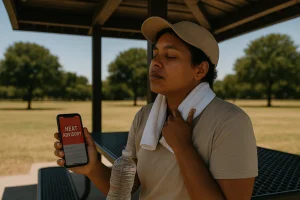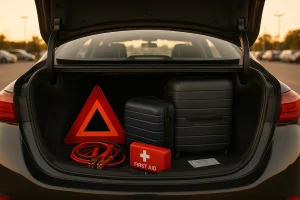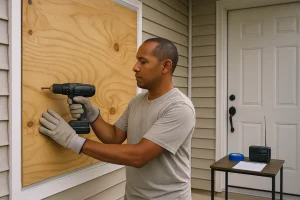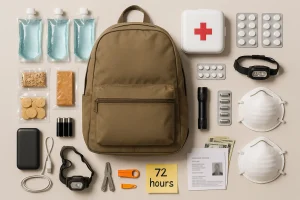Emergency Go-Bag Checklist: 20 Essentials for 72 Hours

Pack once, review quarterly, and keep by the main exit.
Updated: August 20, 2025
Quick Steps: Pack a 72-hour go-bag you can carry fast: water, no-cook food, first aid & meds, power & light, IDs & cash, PPE & hygiene, clothing, and tools. Keep it by the door; review quarterly. If told to evacuate, go early—don’t wait for traffic jams.
This emergency go bag checklist gives clear, evidence-based steps for a fast 72-hour kit. It covers water, no-cook food, first aid and 7–14 day meds, power and light, IDs and cash, PPE and hygiene, clothing and footwear, and smart tools. Build it once, review it quarterly, and store it by your exit so you can leave early if authorities tell you to evacuate.
Why a 72-hour go-bag matters now
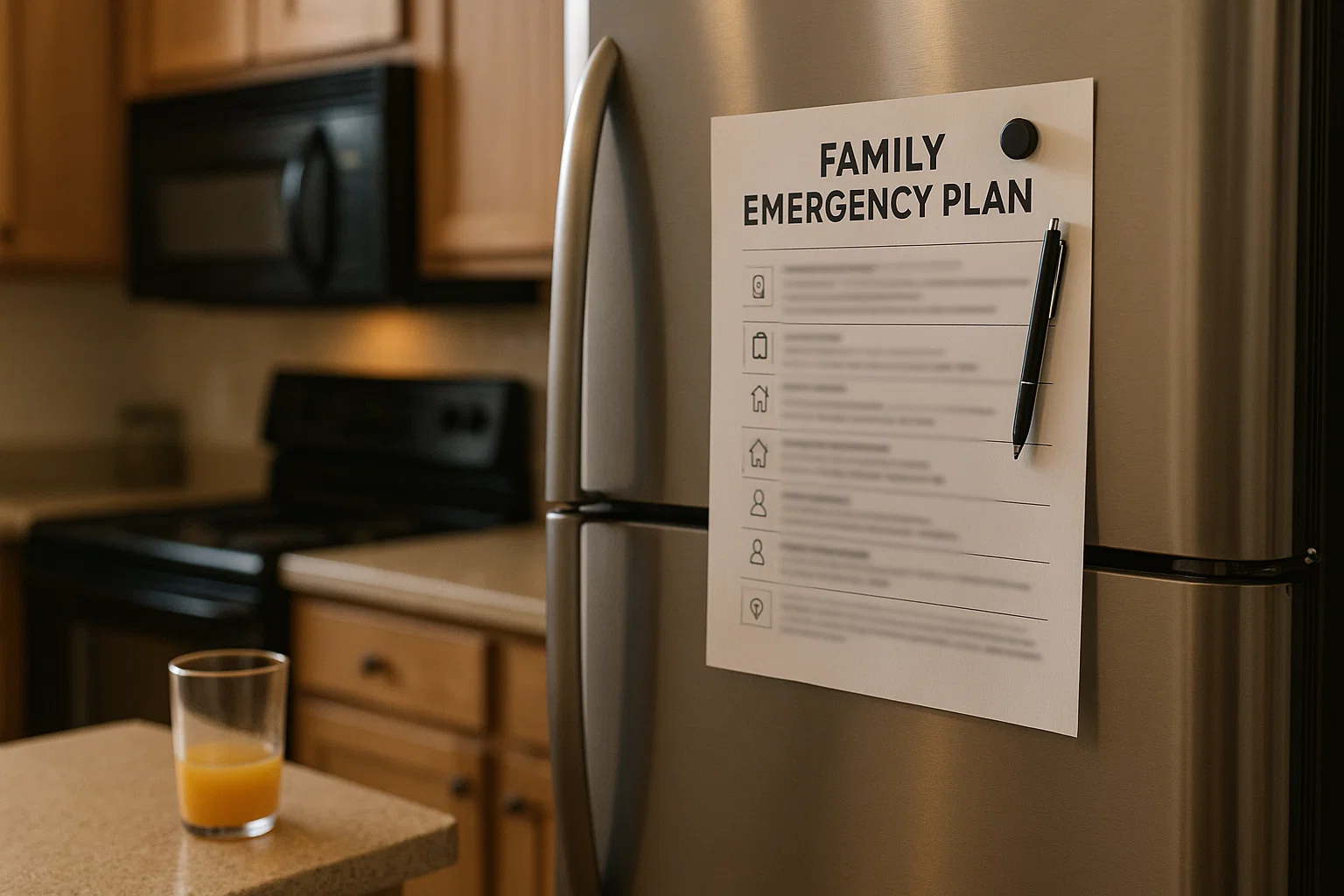
Wildfires, hurricanes, floods, chemical spills, power outages, even major traffic closures—disasters can force you to leave quickly or shelter elsewhere. A go-bag is a pre-packed, grab-and-go kit that keeps you safe, fed, hydrated, reachable, and identifiable for the first 72 hours. It buys time while responders scale up and services restart. This guide gives you an evidence-based checklist, pro packing tips, and a 60-minute assembly plan.
For official guidance on what to pack, see Ready.gov’s kit page at Ready.gov.
Go-bag vs. home kit (and where to store each)

Two different jobs:
- Go-bag: Light enough to carry. Lives by the exit. Built for evacuations, shelters, or staying with friends/family.
- Home kit (shelter-in-place): Larger bins for two weeks—extra water, bulk food, tools. Lives in a cool, dry, accessible spot.
Build the go-bag first. It helps in more scenarios than you think—house fire, gas leak, sudden medical trip, or a mandatory evacuation.
Emergency Go Bag Checklist: 20 Essentials
Start here. Adjust for your climate, meds, and family needs.
- Water: 1–2 liters/person ready-to-go (bottles or pouches) plus purification (tabs or filter).
- No-cook food: calorie-dense bars, pouches, nuts, peanut butter, tuna packets, shelf-stable fruit.
- First aid kit: bandages, gauze, tape, antiseptic, blister care, pain reliever, antihistamine, gloves.
- Medications: 7–14 day supply + list of meds/doses; copies of prescriptions if possible.
- Power bank & cables: phone + headlamp power; car adapter; small wall charger.
- Flashlight/headlamp: hands-free light; spare batteries.
- Weather/NOAA radio: hand-crank or battery model; know local frequencies.
- IDs & documents: copies in a waterproof pouch (ID, insurance, meds list, contacts, pet records).
- Cash: small bills; ATMs and card systems can be down.
- PPE: NIOSH-approved N95s (smoke, dust), nitrile gloves, safety glasses.
- Hygiene: hand sanitizer, wet wipes, tissues, toothbrush/paste, travel soap, toilet bags/liners.
- Clothing: base layer, insulating layer, rain poncho, hat, socks (2–3 pairs).
- Footwear: sturdy walking shoes (if you normally wear sandals/heels).
- Multi-tool & tape: basic repairs with a compact multi-tool and duct/cloth tape roll.
- Whistle & marker: signal for help; write info on tape or bags.
- Small blanket/bivy: compact warmth (mylar bivy or lightweight blanket).
- Waterproof matches/lighter: heat and sterilization; keep dry.
- Maps & list of contacts: printed routes and phone numbers; don’t rely only on the cloud.
- Pet kit (if applicable): food, collapsible bowl, leash, waste bags, carrier, vaccine record.
- Comfort items: glasses/contacts supplies, lip balm, electrolyte packets, simple games for kids.

Table: what to pack, why it matters, quick notes
| Category | Examples | Why | Notes |
|---|---|---|---|
| Water | Bottles/pouches; tabs/filter | Hydration; prevent illness | Carry 1–2 L/person ready; purify more later |
| Food | Bars, nuts, pouches | Energy without cooking | High-calorie, long shelf life, low mess |
| Meds & first aid | 7–14 day meds; bandages | Control symptoms; treat minor injuries | Include list of meds/doses & allergies |
| Power & light | Power bank, cables, headlamp | Stay reachable; move safely in dark | Top off monthly; pack a car adapter |
| PPE & hygiene | N95s, sanitizer, toilet bags | Reduce smoke/germs; sanitation | Fit test N95s; include wipes & soap |
| Docs & cash | ID copies, insurance, $ cash | Prove identity; buy essentials | Waterproof pouch; small bills |
| Tools | Multi-tool, tape, whistle | Simple repairs; signaling | Write info with marker on tape |
| Clothing | Layers, socks, poncho | Warmth, dryness, comfort | Pack for your climate |
| Comms | NOAA radio, maps, contacts | Get alerts; plan routes | Keep a printed contact list |
How to build your go-bag in 60 minutes (numbered plan)
- Pick the bag: 25–35 L backpack with chest/hip straps; comfortable when loaded.
- Gather the 20 essentials from this checklist; place on a table in categories.
- Documents pouch: paper copies (ID, insurance, contacts, meds list); add a small USB with scans if you have one.
- Water & food: pack ready-to-drink water and no-cook foods; add tabs or a compact filter.
- First aid & meds: assemble a compact kit; add meds blister packs and prescriptions list.
- Power & light: charge the power bank; pack cables and a headlamp with fresh batteries.
- Clothing & PPE: roll clothing; add N95s/gloves; pack a rain poncho and hat.
- Tools & hygiene: multi-tool, tape, whistle, marker, sanitizer, wipes, toilet supplies.
- Label & stage: write your name/number on the pack; store by the exit; tell the family where it lives.
- Calendar reminder: set a quarterly check to rotate food/water, recharge power, and update documents.

Water: how much, how to carry, and how to make more
Ready.gov recommends at least one gallon (3.8 L) per person per day for home supplies. You won’t carry that much on foot, so split the plan: carry 1–2 liters ready to drink in the bag, plus a purification method for refills (tablets or a small backpacking filter). Rotate bottled water twice a year (print dates on caps).
Food: no-cook, long shelf life, easy
Choose calorie-dense foods that don’t need cooking: high-protein bars, nut mixes, peanut butter, tuna or chicken packets, fruit cups or dried fruit, instant oatmeal cups (add cold water if needed), shelf-stable milk boxes for kids. Aim for familiar flavors to reduce stress. Add a compact utensil and napkins.
First aid, meds, and special needs
- First aid: adhesive bandages, gauze, tape, antiseptic wipes, blister pads, tweezers, small scissors, pain reliever, antihistamine, gloves.
- Meds: 7–14 day supply if your clinician/pharmacy allows; keep a printed meds list with doses and prescriber info.
- Special items: hearing-aid batteries, glasses/contacts kit, inhalers, EpiPen, diabetes supplies, mobility aids.
Power, light, and communications
- Power bank: charge monthly; store in a small pouch with cables.
- Charging options: wall plug + car adapter; if you own a small solar panel, pack the cable and know how to use it.
- Headlamp + flashlight: headlamp for hands-free tasks; flashlight as backup; pack spare batteries in a zip bag.
- Radio: a small hand-crank or battery NOAA weather radio helps when cell networks are down.
Documents, IDs, and cash
Place copies in a waterproof pouch (zip bag or document sleeve): ID, insurance cards, important phone numbers, meds list, pet records, and a simple proof of address. Add emergency cash in small bills. Keep original IDs on you.

PPE & hygiene
Pack NIOSH-approved N95s (useful for wildfire smoke and dust), nitrile gloves, small sanitizer, hand wipes, tissues, toilet bags/liners, and a travel soap. Add menstrual and infant supplies as needed.
Clothing & footwear
Pack for layers: a moisture-wicking base, a warm layer, and a rain shell/poncho. Add a hat and 2–3 pairs of socks. If you don’t normally wear sturdy shoes, stash a pair near the bag.
Tools that punch above their weight
A compact multi-tool handles small fixes; cloth/duct tape for repairs; a whistle for signaling; a permanent marker to label items or leave information; thin cord (paracord) for securing loads or drying clothes.
Kids, infants, older adults, and pets
- Infants: diapers, wipes, formula or shelf-stable alternatives, bottles, extra clothing, soothing item.
- Kids: comfort toy/game, snacks they like, kid-size N95 (if needed), ID card with your phone numbers.
- Older adults: meds, pill organizer, hearing-aid batteries, spare glasses, simple phone with charger, list of clinicians.
- Pets: food, collapsible bowl, leash/harness, carrier, waste bags, vaccine record (shelters often require it).
Weight, fit, and where to store the bag
The best go-bag is the one you can carry. Keep weight manageable—roughly 10–20% of body weight is a common target for non-hikers. Adjust straps so the load rides high and close to your back. Store the bag by your main exit, off the floor but in reach. Tell everyone where it lives.
Maintenance: set it and don’t forget it
- Quarterly: recharge the power bank, rotate water/food, check batteries and meds expirations.
- Seasonal: swap clothing for heat/cold; add sunscreen and bug repellent in warm months.
- After use: restock immediately so the bag is ready again.
Budget & DIY options
You don’t need fancy gear. Use zip bags for waterproofing, reuse small bottles for toiletries, and buy store-brand bars and tuna packets. Dollar-store items (whistle, tape, tissues, sanitizer) work. Prioritize water, food, meds, and power first; add upgrades later.
Common mistakes to avoid
- Bag is too heavy to carry.
- Forgetting meds and chargers.
- Relying only on the cloud for documents and contacts.
- No cash for places that can’t run cards.
- Letting the kit go stale—no rotation of food/batteries.
Region-specific add-ons
- Wildfire smoke areas: add more N95s; see Wildfire Smoke Safety.
- Hurricane & flood zones: add large trash bags, extra tape, and a marker to label bags; see Hurricane Preparedness Checklist.
- Winter travel: add gloves, beanie, chemical warmers, and extra blanket.
- Heat waves: add electrolyte packets and a sun hat; see Heat Advisory.
Practice run (15 minutes)
Once the bag is packed, do a quick walk around the block wearing it. Adjust straps, move heavy items higher, and check that essential items are easy to reach (phone, light, snacks, N95). Teach kids how to wear their packs.
Advanced Packing & Real-World Scenarios
Your emergency go bag checklist should stay repeatable. Pack heavy items high and close to your back so the load rides stable. Put frequently used items (phone, light, N95, snacks) in the top pocket. Keep water on the outside if your pack has side sleeves. Do a 10-minute walk with the pack once a quarter and adjust straps so weight sits on your hips, not your shoulders.
Don’t move the same kit between locations. Keep a small car kit (blanket, water, triangle, jumper cables, gloves), a micro-kit at work (snacks, charger, compact light), and your main pack by the home exit. Commuters: stash walking shoes and a fold-flat bottle at the office.
Food that actually gets eaten matters. Rotate snacks your household likes. Mix protein bars, nut butters, tuna/chicken packets, trail mixes, and fruit cups. Label a small “first to eat” pouch for travel days so snacks don’t go stale.
Carry 1–2 liters of water and a treatment method. Tablets are tiny and dependable; compact filters work if you have a source. Never drink floodwater. If storing water in a hot trunk, keep bottles in a bin out of sunlight and rotate more often.
First aid beyond band-aids: add blister pads, a triangular bandage, and an elastic wrap. Include small saline vials for eye/skin rinse. Keep meds in original blister packs with a printed list and prescriber info; rotate by expiry dates.
Use a 10k–20k mAh power bank (label it) and one cable per device. A low-draw LED headlamp beats a phone light for hours-long tasks. If you own a small solar panel, pack it only if you’ve tested it at home.
Papers matter when systems are down. Place copies of ID, insurance, and an emergency contact list in a waterproof sleeve. Back them up to a passworded cloud folder. If you carry a USB stick, encrypt it.
PPE & hygiene: NIOSH-approved N95s for smoke/dust outdoors; fit carefully at the nose clip. Add sanitizer, wipes, toilet bags/liners, and a small soap. Comfort items (lip balm, lotion) help during long evacuations.
For infants: formula, bottles, diapers/wipes, spare clothing, soothing item. For kids: favorite snacks, a compact game/coloring pad, kid-size N95 if needed, ID card with your phone. For older adults: pill organizer, hearing-aid batteries, spare glasses, simple phone, clinician list. For pets: 3-day food, collapsible bowl, leash/carrier, waste bags, and vaccine record.
Upgrade by region: more N95s for smoke (wildfire smoke safety); tape, large trash bags, and marker for hurricanes (hurricane preparedness); warm gear for winter; electrolytes and a sun hat for heat (heat advisory).
Practice a 15-minute drill and add two calendar reminders—quarterly (rotate, recharge) and seasonal (swap clothing, check expirations). The emergency go bag checklist becomes muscle memory when everyone can grab the bag and go.
How to use this emergency go bag checklist
Print this emergency go bag checklist and tape it inside your front closet or near your exit. Pack the bag once, then follow the same steps every quarter: recharge the power bank, rotate snacks and meds, and replace anything you used. During alerts, this emergency go bag checklist lets your family split up the tasks quickly so you can leave early and avoid traffic.
Printable emergency go bag checklist (summary)
Use this printable emergency go bag checklist summary when packing: water (1–2 L on you + treatment), no-cook food you’ll actually eat, first aid + 7–14 day meds, power bank + cables, headlamp, IDs & cash, PPE/N95s, hygiene, season-ready clothing/footwear, and simple tools (multitool, tape, markers). Keep it by the exit and practice a 15-minute grab-and-go drill.
FAQ: Emergency Go Bag Checklist
What is an emergency go bag checklist? It’s a short, repeatable list of must-have items for the first 72 hours. This emergency go bag checklist focuses on water, no-cook food, first aid and meds, power and light, ID and cash, PPE, clothing, and tools.
How heavy should my pack be? Aim for the lightest setup that still covers this emergency go bag checklist. Most adults target 10–20 lb (4.5–9 kg); fit the hip belt so weight rides on your hips.
Where do I store it? By the door you use most, not buried in a closet. The idea of an emergency go bag checklist is speed—everyone should know where it lives.
How often do I rotate supplies? Quarterly. Put two calendar reminders: one quarterly to review this emergency go bag checklist (recharge, rotate, replace) and one seasonal to swap clothing.
Do I really need N95s? Yes, for smoke and dust. The emergency go bag checklist includes NIOSH-approved N95s; fit the nose clip tightly and practice wearing one.
Can one bag cover a whole family? Each person should have their own basics, but one larger bag can carry shared items. Use the emergency go bag checklist as the master list and divide tasks.
What if I rent or live in a small space? Keep a compact pack by the exit and a small car/work kit. Even in a studio, this emergency go bag checklist fits in a single 20–30L backpack.
Bottom line: practice the plan, label your gear, and update this emergency go bag checklist after any real-world use.
Related Guides
- Hurricane Preparedness Checklist 2025: Before, During & After
- Wildfire Smoke Safety: HEPA at Home, Masks, and When to Stay Inside
- Heat Advisory: Signs of Heat Illness & What to Do Now
- Labor Day Travel Safety: Car Kit, Rideshare & Hotel Checks
- More in Safety & Preparedness
Sources
- Ready.gov — Build a Kit
- Ready.gov — Evacuation
- American Red Cross — Survival Kit Supplies
- CDC — Food Safety After a Disaster
- CDC — Safe Water in Emergencies
- EPA — Emergency Disinfection of Drinking Water
- CDC — Wildfire Smoke
- FEMA — Individual Assistance
This guide is educational. Not medical or legal advice. Follow official alerts and evacuation orders. In emergencies, call 911.


